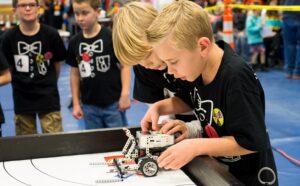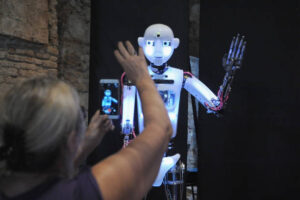Rapid Rise of Robotics has been the topic of discussion. The dynamic landscape of technological advancements has witnessed an unprecedented surge in robotics.
Real-world examples show how rapid robotics reshapes industries and revolutionizes daily life.
For instance, Boston Dynamics, a pioneer in robotics, has introduced the next iteration of its humanoid robot, Atlas, equipped with advanced AI algorithms that enable it to navigate complex environments with unprecedented agility and adaptability.
This is just one of the many instances highlighting the breakthroughs that have propelled the industry forward, challenging preconceived notions of what robots can achieve.
As Atlas traverses intricate terrains, its bipedal design mimics human movement, showcasing the potential for robots to seamlessly integrate into our daily lives, from assisting in search and rescue operations to household chores.
Advancements in Artificial Intelligence (AI) Integration:
Real-world applications of AI in robotics are transforming the way machines operate. Take, for instance, the OpenAI Robotics Lab’s deployment of reinforcement learning algorithms to train robotic hands.
These hands can manipulate objects with dexterity and precision, learning from experience to refine their movements over time.
An exemplary instance is the robotic hand’s ability to grasp delicate items, demonstrating the transformative impact of AI integration, enabling robots not just to execute programmed tasks but to learn and adapt autonomously.
The implications of such advancements extend beyond manufacturing, with the potential for AI-integrated robots to assist individuals with disabilities, providing a more independent and fulfilling life experience.
Agile Manufacturing and Industry
In the manufacturing sector, companies like Siemens have embraced rapid robotics to enhance their production processes.
Siemens’ robotic systems, integrated with AI-driven predictive maintenance, ensure minimal downtime and optimized production schedules.
This real-world implementation exemplifies the synergy between agile manufacturing principles and rapid robotics, resulting in increased efficiency, reduced costs, and improved overall productivity.
The assembly lines, powered by these robotic systems, showcase the marriage of precision and speed that defines the future of manufacturing.
As these systems evolve, the interconnectedness of smart factories is laying the groundwork for a new era of industrial autonomy, where robots collaborate in real time to streamline processes and adapt to changing production needs seamlessly.
Human-Robot Collaboration Reaches New Heights:
The collaboration between humans and robots is no longer confined to controlled environments.
At Tesla’s Gigafactories, robotic arms work seamlessly alongside human workers in the production line, showcasing the potential for a harmonious coexistence.
Safety features, such as advanced sensors and real-time monitoring, ensure a secure working environment, marking a paradigm shift in how robots and humans collaborate on a day-to-day basis.
This integration not only boosts productivity but also fosters a collaborative work culture where humans and robots complement each other’s strengths.
Companies are increasingly investing in training programs that equip human workers with the skills to operate, troubleshoot, and collaborate with their robotic counterparts, fostering a workforce that seamlessly adapts to the evolving nature of modern manufacturing.
Autonomous Vehicles and Drones
The streets and skies are witnessing a proliferation of autonomous vehicles and drones, each a testament to rapid robotics advancements.
Waymo, a subsidiary of Alphabet Inc., has deployed a fleet of self-driving taxis that navigate the streets autonomously.
Similarly, companies like DJI have introduced advanced drones equipped with computer vision and obstacle avoidance, revolutionizing aerial photography and surveillance.
These real-world examples highlight the transformative impact of rapid robotics in transportation and beyond, showcasing a future where autonomous vehicles and drones seamlessly integrate into our daily lives, offering convenience and efficiency.
The continued development of urban air mobility solutions, such as passenger-carrying drones, is poised to redefine the concept of transportation, reducing congestion and enhancing accessibility in densely populated urban areas.
V. Healthcare Innovations:
In the healthcare sector, the da Vinci Surgical System has become a hallmark of robotic-assisted surgeries.
Developed by Intuitive Surgical, this system allows surgeons to perform minimally invasive procedures with enhanced precision.
The real-world impact is evident in reduced patient recovery times and improved surgical outcomes. Robotic systems, like the da Vinci, are emblematic of how rapid robotics is reshaping the landscape of medical interventions.
As these systems become more widespread, patients globally stand to benefit from advancements that enhance the precision and efficacy of medical procedures.
The integration of AI algorithms in healthcare robotics is paving the way for personalized treatment plans, leveraging patient data to optimize surgical approaches and improve overall healthcare outcomes.
The Rise of Swarm Robotics
Swarm robotics finds practical applications in environmental monitoring, and Festo’s BionicANTs exemplify this concept.
These ant-inspired robots work collaboratively to accomplish tasks, such as sorting and transporting objects.
Additionally, the BionicANTs by Festo are making significant strides in disaster response scenarios.
In simulated emergencies, these robotic swarms have demonstrated the ability to swiftly and efficiently navigate through complex environments, locating and rescuing survivors.
The adaptability and coordination displayed by these robotic ants underscore their potential in addressing urgent situations where human access may be challenging, marking a groundbreaking advancement in the use of swarm robotics for humanitarian purposes.
As we witness the BionicANTs’ success in environmental monitoring and disaster response, it becomes evident that these bio-inspired robotic systems are not only efficient but also versatile, offering solutions across a spectrum of critical scenarios.
From precision agriculture to environmental conservation, the scalability and adaptability of swarm robotics promise to redefine how we approach complex challenges on a global scale.
Environmental and Agricultural Applications
In agriculture, the emergence of autonomous farming machinery is revolutionizing traditional practices.
John Deere’s autonomous tractors, equipped with AI and GPS technology, can navigate fields, plant crops, and optimize resource usage without human intervention.
This real-world application highlights how rapid robotics is addressing global challenges by creating sustainable solutions in agriculture.
The use of autonomous tractors not only improves efficiency but also contributes to resource conservation, marking a significant stride towards more sustainable and environmentally friendly farming practices.
The integration of advanced sensors in these autonomous systems allows for precise monitoring of soil health, crop conditions, and environmental factors, empowering farmers with real-time data to make informed decisions and optimize agricultural practices for both productivity and environmental stewardship.
Challenges and Ethical Considerations
The real-world impact of rapid robotics also brings forth ethical considerations. For example, the deployment of robotic process automation (RPA) in various industries has raised concerns about potential job displacement.
Companies like Amazon, in their use of automated fulfillment centers, have faced scrutiny regarding the well-being and job security of their human workforce.
These challenges underscore the importance of ethical frameworks to guide the responsible development and deployment of rapid robotics technologies.
Striking a balance between technological innovation and social responsibility is crucial to ensure that the benefits of rapid robotics are shared equitably across society.
Additionally, ongoing efforts to reskill and upskill the workforce, coupled with the implementation of inclusive policies, can help mitigate the potential negative impacts of automation on employment.
The Future Landscape
Looking ahead, the collaboration between OpenAI and NASA on the development of robotic systems for space exploration offers a glimpse into the future of rapid robotics.
The use of advanced robotic systems in extraterrestrial environments demonstrates the limitless possibilities that lie ahead.
As we venture into uncharted territories, the integration of quantum computing and continued breakthroughs in materials science will undoubtedly propel rapid robotics into new realms, further expanding the horizons of what robots can achieve.
This collaboration not only opens doors to exploring other planets but also drives advancements that have the potential to benefit life on Earth.
The fusion of cutting-edge technologies and space exploration is a testament to the ever-expanding role of rapid robotics in shaping the future of humanity.
From self-replicating robots on distant planets to innovative solutions for sustainable living on Earth, the future landscape of rapid robotics promises a tapestry of possibilities that go beyond our current imagination.
Conclusion
In conclusion, the real-world examples presented throughout exemplify the tangible impact of rapid robotics on industries and everyday life.
From manufacturing and healthcare to transportation and agriculture, robots are no longer confined to the realm of science fiction.
As we navigate the complexities and ethical considerations of this evolving field, the transformative potential of rapid robotics promises a future where innovation is not just a concept but a reality that reshapes the way we live and work.
The journey has only just begun, and the real-world applications of rapid robotics are poised to define the next era of technological advancement.
As we stand on the cusp of a robotic renaissance, the fusion of human creativity and machine efficiency holds the key to unlocking unprecedented possibilities that will shape the trajectory of our collective future.
FAQs
- What is rapid robotics, and how does it differ from traditional robotics?
- Can you provide more examples of real-world applications of rapid robotics in healthcare?
- How are autonomous vehicles and drones utilizing rapid robotics for improved functionality?
- What ethical considerations are associated with the deployment of rapid robotics in various industries?
- How do robotic systems in agile manufacturing enhance efficiency and productivity?
- What safety measures are implemented in human-robot collaboration scenarios, such as those seen in Tesla’s Gigafactories?
- How do swarm robotics, exemplified by Festo’s BionicANTs, contribute to environmental monitoring and disaster response?
- In agriculture, how are autonomous tractors with AI and GPS technology transforming traditional farming practices?
- What challenges does the deployment of robotic process automation (RPA) pose, and how can they be mitigated?
- How does the collaboration between OpenAI and NASA on robotic systems for space exploration represent the future landscape of rapid robotics?






